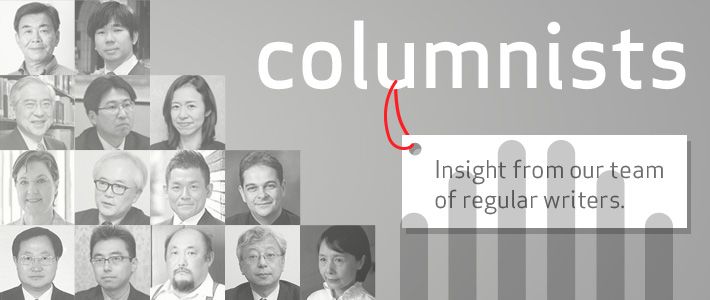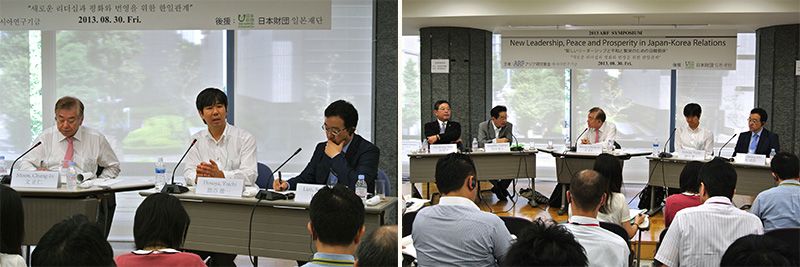
Japan and South Korea: Time for a Reboot
Politics- English
- 日本語
- 简体字
- 繁體字
- Français
- Español
- العربية
- Русский
On the night of September 5, 2013, Prime Minister Abe Shinzō and President Park Geun-hye of South Korea chatted briefly just before an official dinner held to welcome delegates to the Group of Twenty summit in St. Petersburg. Since taking office in February, President Park had previously avoided holding formal talks with Abe, who has been back in office since December 2012. The Korean position is that gaffes and insensitive remarks on historical issues by Japanese politicians, along with visits to Yasukuni Shrine by Deputy Prime Minister Asō Tarō and others, make conditions unsuitable for a summit. This meeting in Russia therefore marked the first time the Japanese and South Korean heads of government had met face-to-face, albeit briefly. This shows just how frosty relations between the two countries have become.
Following a meeting with German Chancellor Angela Merkel at the summit in St. Petersburg, President Park said that “There should be efforts to heal the wounds of history. I think things will be difficult if the wounds keep being touched without efforts to heal them.” On September 6, the South Korean government announced that it was banning the import of all seafood products from Fukushima and seven other Japanese prefectures, citing safety concerns about leaks of radioactive water from the Fukushima Daiichi power station. Why does Korea continue to take such a critical attitude to Japan?
50 Years on from Normalization: Two Completely Different Situations
First of all, it is essential to understand that the relationship has changed fundamentally in the nearly 50 years since diplomatic relations were normalized with the signing of the Treaty on Basic Relations in 1965. In 1965, only 22,000 people traveled between the two countries. By 2010, this had risen to more than 5 million. The same relationship therefore takes place in a vastly different setting today. The volume of travel and human exchange, the international environment in which the two countries find themselves, and the political systems in place in each country—all of these are vastly different now from what they were in 1965.
When the treaty was signed, Korean politics was dominated by President Park Chung-hee (father of the current president), who seized power in a coup d’état. This was the Cold War era, with an authoritarian dictatorship focused on development. In building a new relationship between Korea and Japan, the views and national sentiment of the Korean people were not adequately reflected. South Korea was a country on the front lines of the Cold War, face-to-face with the Communist enemy: North Korea, the Soviet Union, and China. Korea’s relationships with the United States and Japan were of overwhelming importance, both economically and in terms of national security. Japanese economic assistance and investment were also indispensable for modernizing the economy. In Japan, meanwhile, foreign policy centered on the Ministry of Foreign Affairs and the Liberal Democratic Party, under the one-party dominance of the LDP, led by Satō Eisaku, prime minister from 1964 to 1972. This led to a compromise between the two governments that had little in common with popular opinion in either country. This is how the treaty came about.
So Japan’s modern postwar relationship with Korea was originally based on an agreement reached between two governments in the 1960s. We might call this “Japan-Korea Relations 1.0.” We have now entered a totally different era. The current relationship is rooted in popular opinion and national sentiment. We can refer to this new relationship as “Japan-Korea Relations 2.0.” The democratization of Korean politics and the advent of a mature civic society have led to a situation in which the population is able to express national sentiment more freely and more aggressively than was possible in the past. Rather than exercising a restraining influence, the Korean media tends to exacerbate it. This means that the country’s political leaders cannot afford to ignore the national sentiment. And in South Korea, it is the national governments of Korea and Japan that bear the brunt of criticisms and complaints from the media and popular opinion.
 On August 30, 2013, a symposium with the title “New Leadership, Peace, and Prosperity in Japan-Korea Relations” was held in Tokyo. The symposium was sponsored by the Asia Research Fund, with support from the Nippon Foundation. The author took part in a panel during Session 1 with the title “Democracy and Peace.” Also on the panel were Moon Chung-in, professor at Yonsei University; Kil Jeong-woo, member of the National Assembly for the Saenuri Party; Sengoku Yoshito, former chief cabinet secretary; and Lim Seong-ho, professor at Kyung Hee University. The panel discussed the impact of democracy in both countries on bilateral diplomacy. (Photo courtesy of the Nippon Foundation)
On August 30, 2013, a symposium with the title “New Leadership, Peace, and Prosperity in Japan-Korea Relations” was held in Tokyo. The symposium was sponsored by the Asia Research Fund, with support from the Nippon Foundation. The author took part in a panel during Session 1 with the title “Democracy and Peace.” Also on the panel were Moon Chung-in, professor at Yonsei University; Kil Jeong-woo, member of the National Assembly for the Saenuri Party; Sengoku Yoshito, former chief cabinet secretary; and Lim Seong-ho, professor at Kyung Hee University. The panel discussed the impact of democracy in both countries on bilateral diplomacy. (Photo courtesy of the Nippon Foundation)
Building Stability Through Exchange and Understanding
In a way, it could be said that the advent of mature democracy in Japan and South Korea has imparted a tricky element to the bilateral relationship. It has often been observed that democracy causes difficulties for a country’s foreign policy. In Democracy in America, Alexis de Tocqueville argued that “Democracy is favorable to the increase of the internal resources of the State . . . But a democracy is unable to regulate the details of an important undertaking, to persevere in a design, and to work out its execution in the presence of serious obstacles.” Tocqueville believed this was because “the mass of the people may be led astray by ignorance or passion …” In South Korea, democratization means that people are now free to criticize their political leaders for the way they are responding to the wartime “comfort women” controversy and Japanese views of historical issues. The fact that Japan and Korea are both now mature democracies is precisely what makes the relationship difficult. In order to build a more mature and stable relationship, the civil society in both countries needs to develop greater maturity. Work needs to be done in both countries to establish a healthy, positive image of the other. Both sides should face up to history rationally rather than emotionally. Having understood each other’s position and feelings, perhaps we will be able to move ahead calmly and achieve mutual benefits through cooperation and concord.
The first version of the Japan-Korea relationship, based on a government-level agreement that failed adequately to reflect national sentiment, was a feeble thing. There would be no sense in attempting to return to such a weak relationship. Instead, we must work to build a more robust, multifaceted, and comprehensive relationship between our two countries—one better suited to the current age. I hope that a rebooted version, “Japan-Korea Relations 2.0,” will allow the people of both countries to understand one another through meaningful exchanges.
(Originally written in Japanese on September 7, 2013.)
diplomacy Abe Shinzō South Korea Foreign Affairs Aso Taro Park Geun-hye historical issues